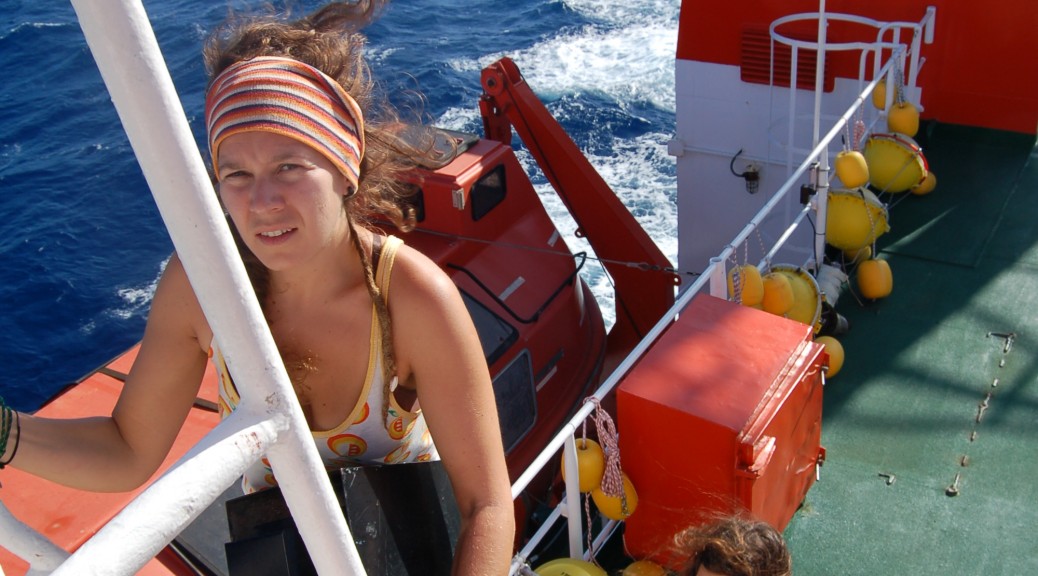S 29° 48’ 2″ E 82° 42’ 50″ – A dorado shimmers below the surface, flitting its radioactive blue fins and flicking its yellow tail as it circles a vertical net dangling from the Hespérides. The dorado is the largest animal we have seen since leaving the African coast. It might see our nets as competition, or as a handily packaged snack. An open ocean predator, the dorado is probably laced with polychlorinated biphenyl (PCBs), one of the compounds subject to limits by the Stockholm Convention on Persistent Organic Pollutants (POPs).
Despite successful international efforts to limit the use of early pollutants such as dichlorodiphenyltrichloroethane (DDT), people continue to invent new substances which leak from everyday use into the wider environment. Some of those chemicals break down quickly under the sun’s ultraviolet rays or by mixing with water. They pose little long-term threat. Researchers refer to more durable chemicals as persistent. It’s a good word for the pollutants.
Depending on the arrangement of their molecules, persistent pollutants from pesticides to fire retardant can infiltrate the bodies of living things. When larger things eat many smaller things containing these pollutants, they accumulate high levels of the normally rare substances. In some cases, those pollutants will stay near their source, such as a factory or waste dump, and remain a local issue. But others are semi-volatile, meaning that the sun’s rays may lift them into the atmosphere and drift across borders and oceans.
On the breezy roof of the Hespérides’ bridge, over 1,500 nautical miles from the nearest continent, Gema Hernan Martínez and Belén González Gaya are collecting a subtle signature of civilization. About once a day the pair change filters in a set of black A-frame boxes. When they return to the wet lab, with reggae playing on a nearby laptop, the pair will flush the spongy filters with a solvent that captures aerosol and gas pollutants, for further analysis back home.
Their search for pollutants will be guided by a 2006 review in Environmental Science and Technology which identified 30 especially durable and far-traveling POPs based on their chemical structure. Their supervisor Jordi Dachs, an atmospheric scientist at the CSIC’s Institute of Environmental Assessment and Water Research (IDAEA) and chief scientist of this leg, says that identifying the POPs is a slow, difficult process, as there are few off-the-shelf methods of screening for them. But on previous voyages he has found the pollutants several days’ sail from coasts. “If you don’t find them your method is wrong,” he says. “POPS are everywhere.”
The difficulty of screening for POPs and their ubiquity in our economy mean that monitoring and regulation lag behind the creation of new POPs. The Stockholm Convention, critics sneer, only dealt with obsolete chemicals which industry was phasing out already or which were already banned in many countries. Subsequent updates, such as the upcoming meeting in Geneva from 25 to 29 April, have added new chemicals to the list, but Dachs says the process is too slow and complicated. His colleague Begoña Jiménez Luque of the General Organic Chemistry Institute (IQOG) in Madrid says, “What’s bad isn’t making new chemicals, it’s that when you make new ones, you don’t wait to understand the toxicity.”
But understanding the toxicity is also a slow, laborious process. Researchers have run experiments in which they exposed laboratory-cultivated plankton to very high levels of POPs, perhaps 10,000 times higher than those detected in the environment. Those experiments kill around 50% of the plankton. Dachs and colleagues are trying to design more realistic tests that kill fewer plankton and use wild plankton, who may not be as robust as laboratory plankton. On the Hespérides, the team exposes freshly caught plankton to varying levels of POPs for 24 hours and then freezes the plankton. Back on land they will study the plankton’s DNA and RNA to see how the chemicals have affected the genetic activity of the creatures.
At the same time the team is collecting rainwater and seawater so that they can map the distribution and flow of POPs from the atmosphere to the sea surface. The flow is not just one-way. On a windy day last week, when it was hard to walk, Hernan and González climbed up to the roof of the bridge again. The wind had shut down most observations on the ship, but it made their observations more valuable: with so much wind they had a chance of collecting salts and pollutants lofted from the sea’s frothing surface. Those particles will float in the atmosphere until a rain flushes them back into the sea, where plankton will pick them up and the dorado will have another chance to eat POPs.
Previous posts in this series:
Malaspina expedition: Deep sea -omics (28 February 2011)
Malaspina expedition: Catching our breath (24 February 2011)
Malaspina expedition: Data deluge (21 February 2011)
Malaspina expedition: Water, water everywhere and not a drop to sample (17 February 2011)
Malaspina expedition: Starting out with a splash (14 February 2011)
Malaspina expedition: Shipping out (11 February 2011)
Images: Gema Hernan Martínez (left) and Belén González Gaya carry atmospheric filters (top); Hernan and González change filters. / Lucas Laursen. Map indicates approximate location of dispatches.
First published on Nature’s The Great Beyond: [html] [pdf]

this post was very well written.. thanks a lot for this. I’m gonna bookmark your site.